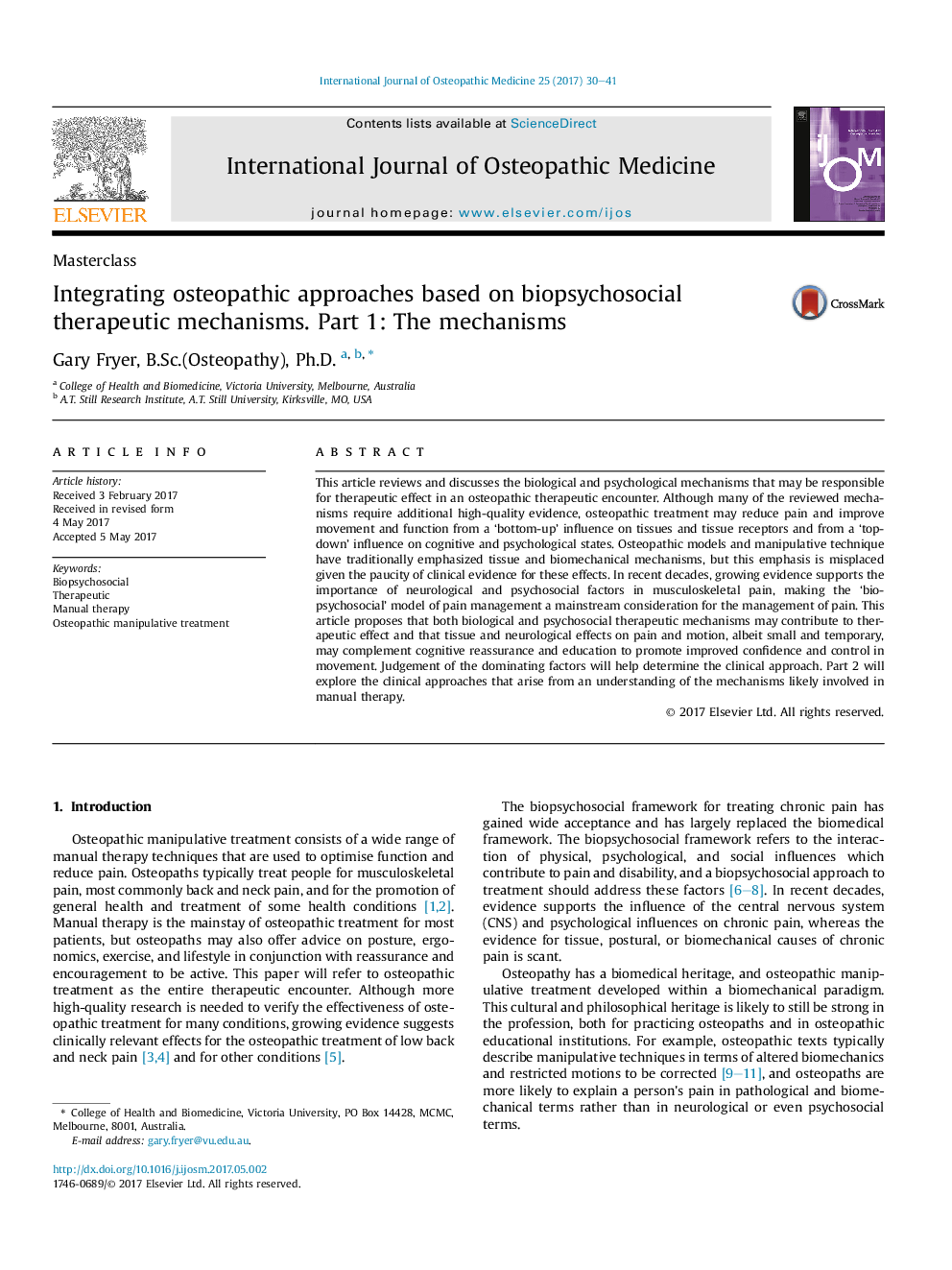| کد مقاله | کد نشریه | سال انتشار | مقاله انگلیسی | نسخه تمام متن |
|---|---|---|---|---|
| 5563869 | 1562983 | 2017 | 12 صفحه PDF | دانلود رایگان |
عنوان انگلیسی مقاله ISI
Integrating osteopathic approaches based on biopsychosocial therapeutic mechanisms. Part 1: The mechanisms
ترجمه فارسی عنوان
یکپارچه سازی رویکردهای استئوپاتیک مبتنی بر مکانیسم های درمانی روان پزشکی. قسمت 1: مکانیسم ها
دانلود مقاله + سفارش ترجمه
دانلود مقاله ISI انگلیسی
رایگان برای ایرانیان
کلمات کلیدی
ترجمه چکیده
در این مقاله مکانیسم های زیست شناختی و روانشناختی که ممکن است مسئول اثرات درمانی در برخورد روحی استئوپاتیک هستند، مورد بررسی و بحث قرار گیرد. اگر چه بسیاری از مکانیسم های مورد بررسی نیاز به شواهد با کیفیت عالی دارند، درمان پوکی استخوان ممکن است درد را کاهش دهد و حرکت را بهبود بخشد و از تأثیر "پایین به بالا" بر گیرنده های بافت و بافت و از یک "بالا به پایین" بر وضعیت شناختی و روانی . مدل های پوکی استخوان و تکنیک های دستکاری به طور سنتی بر سازه های بافت و بیومکانیکی تأکید دارند، اما با توجه به کمبود شواهد بالینی برای این اثرات، این تاکید بی ارزش است. در دهه های اخیر، شواهد رو به رشد، اهمیت عوامل عصبی و روانی-اجتماعی در درد اسکلتی عضلانی را تقویت می کنند و مدل مدیریت بیولوژیک درد را به عنوان مدیریتی درد در نظر می گیرند. این مقاله پیشنهاد می کند که هر دو مکانیسم های درمانی زیست شناختی و روان شناختی ممکن است به تاثیر درمانی کمک کنند و اثرات بافتی و عصبی بر درد و حرکت، هرچند کوچک و موقت، ممکن است مکمل شناختی و آموزش و پرورش را برای ارتقاء اعتماد به نفس و کنترل در حرکت افزایش دهند. قضاوت از عوامل غالب به تعیین رویکرد بالینی کمک می کند. قسمت 2 رویکردهای بالینی را که از درک مکانیسم های احتمالا درگیر در درمان دستی به وجود می آید، کشف می کند.
موضوعات مرتبط
علوم پزشکی و سلامت
پزشکی و دندانپزشکی
طب مکمل و جایگزین
چکیده انگلیسی
This article reviews and discusses the biological and psychological mechanisms that may be responsible for therapeutic effect in an osteopathic therapeutic encounter. Although many of the reviewed mechanisms require additional high-quality evidence, osteopathic treatment may reduce pain and improve movement and function from a 'bottom-up' influence on tissues and tissue receptors and from a 'top-down' influence on cognitive and psychological states. Osteopathic models and manipulative technique have traditionally emphasized tissue and biomechanical mechanisms, but this emphasis is misplaced given the paucity of clinical evidence for these effects. In recent decades, growing evidence supports the importance of neurological and psychosocial factors in musculoskeletal pain, making the 'biopsychosocial' model of pain management a mainstream consideration for the management of pain. This article proposes that both biological and psychosocial therapeutic mechanisms may contribute to therapeutic effect and that tissue and neurological effects on pain and motion, albeit small and temporary, may complement cognitive reassurance and education to promote improved confidence and control in movement. Judgement of the dominating factors will help determine the clinical approach. Part 2 will explore the clinical approaches that arise from an understanding of the mechanisms likely involved in manual therapy.
ناشر
Database: Elsevier - ScienceDirect (ساینس دایرکت)
Journal: International Journal of Osteopathic Medicine - Volume 25, September 2017, Pages 30-41
Journal: International Journal of Osteopathic Medicine - Volume 25, September 2017, Pages 30-41
نویسندگان
Gary B.Sc.(Osteopathy), Ph.D.,
